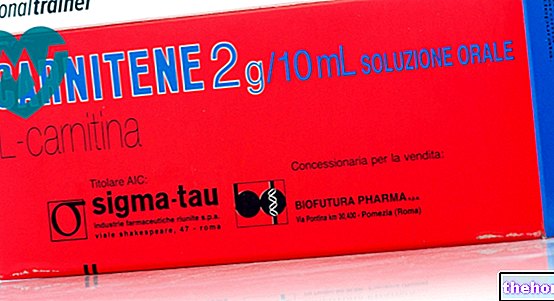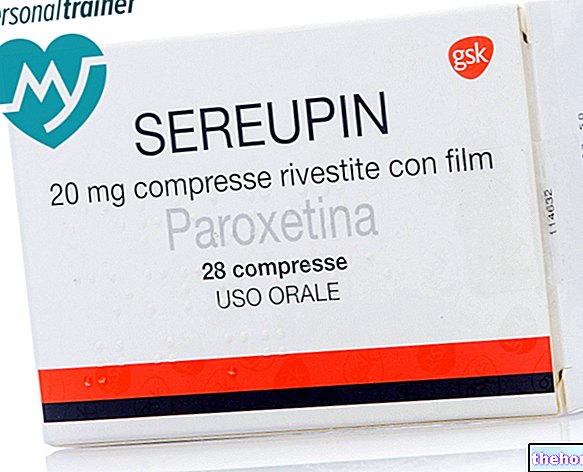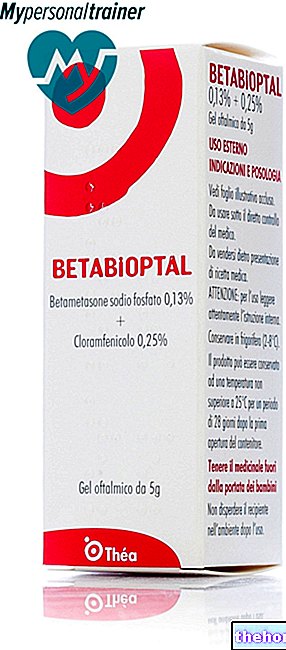Active ingredients: Oxybuprocaine (oxybuprocaine hydrochloride)
Novesina 4mg / ml eye drops, solution
Why is Novesina used? What is it for?
Novesina contains the active ingredient oxybuprocaine hydrochloride, a local anesthetic, particularly suitable for creating a "surface anesthesia at the level of the mucous membranes.
Novesina is used in case of:
- measurement of the internal pressure of the eye (tonometry with the Schlötz apparatus), exams to the contact lenses.
- extractions of foreign bodies from the cornea
- preparation for injections in the eye (subconjunctival and retrobulbar).
- puncture of the anterior chamber for the purpose of diagnosis
- small surgical operations, for example pterygium (abnormal growth of the conjunctiva), chalazion (swelling and inflammation of the eyelid due to inflammation of the lacrimal glands), excision of small tumors.
Contraindications When Novesina should not be used
Do not use Novesina if you are allergic to oxybuprocaine hydrochloride or any of the other ingredients of this medicine.
Precautions for use What you need to know before taking Novesina
Talk to your doctor before using Novesina especially if you have problems:
- to the liver
- to the heart
- to blood vessels
Novesina will be given to you by your doctor only when needed.
Do not use Novesina repeatedly as it can cause damage to the cornea.
In the anesthesia of the cornea and conjunctiva of the eye, Novesina 4mg / ml eye drops does not cause a burning sensation and therefore avoids contracture of the eyelid muscles (blepharospasm).
Novesina is tolerated by the corneal epithelium and does not cause
- dilation of the pupil (mydriasis)
- redness (hyperemia) of the conjunctivae
- allergy phenomena
- epithelial lesions.
Interactions Which drugs or foods can modify the effect of Novesina
Tell your doctor if you are using, have recently used or might use any other medicines.
Novesina is not compatible with
- silver nitrate (bactericidal)
- mercury salts (disinfectants)
- alkaline substances (e.g. detergents)
Warnings It is important to know that:
Pregnancy and breastfeeding
If you are pregnant or breast-feeding, think you may be pregnant or are planning to have a baby, ask your doctor for advice before using this medicine.
The use of oxybuprocaine hydrochloride during pregnancy and lactation has not been adequately studied. Your doctor will consider whether the benefits to you clearly outweigh the risks to the fetus / child before giving you Novesina.
Driving and using machines
Wait until the anesthetic effect of Novesina has ended before driving or using machines.
Dose, Method and Time of Administration How to use Novesina: Posology
Always use this medicine exactly as your doctor has told you.
If in doubt, consult your doctor or pharmacist.
Novesina 4mg / ml eye drops, solution will be administered by letting the drops fall into the conjunctival sac, ie inside the lower part of the eye.
Measurement of the internal pressure of the eye (tonometry) with the Schlötz device, contact lens examinations
The recommended dose is one or two drops, one minute before applying the tonometer.
Extraction of foreign bodies from the cornea, preparation for injections in the eye (subconjunctival and retrobulbar)
The recommended dose is one drop 2-3 times over the course of 3 minutes.
Puncture of the anterior chamber for diagnosis, small surgical interventions (pterygium, chalazion, excision of small tumors)
The recommended dose is one drop every 30 seconds repeated 5 - 10 times with the addition of 1 - 2 drops of 1% adrenaline.
In case of applications on large surfaces and in case of instillation, the maximum dose is 1.5 mg per kg of body weight, ie for a 70 kg adult it is 100 mg of oxybuprocaine hydrochloride which corresponds to 25 ml of the solution NOVESINA 4mg / ml.
Overdose What to do if you have taken too much Novesina
In case of accidental ingestion of an excessive dose of Novesina or prolonged use of the medicine, contact your doctor immediately or go to the nearest hospital, as toxic phenomena may occur.
Symptoms can be:
- difficulty in breathing
- convulsions.
If you have any further questions on the use of this medicine, ask your doctor or pharmacist.
Side Effects What are the side effects of Novesina
Like all medicines, this medicine can cause side effects, although not everybody gets them.
With the use of Novesina you may experience one or more of the following side effects:
- mild burning sensation immediately after instillation which usually regresses rapidly.
- transient redness (hyperemia) of the conjunctivae
- allergic reactions to the conjunctiva
- allergic reactions of the eyelids and skin around the eyes
- corneal lesions: superficial lesions, erosions, inflammations within the cornea (stromal infiltrates)
- cataract
- allergic phenomena after a second application.
As a result of absorption through the mucous membranes or damaged skin, effects involving the whole organism can also occur:
- excitation of the central nervous system
- nausea
- He retched
- depression of the cardiovascular system with pallor, sweating, hypotension
- heart rhythm disturbances (arrhythmias)
- abnormal accumulation of hemoglobin in the blood (methemoglobinemia).
Reporting of side effects
If you get any side effects, talk to your doctor or pharmacist. This includes any possible side effects not listed in this leaflet. You can also report side effects directly via the national reporting system at www.agenziafarmaco.it/it/responsabili. By reporting side effects you can help provide more information on the safety of this medicine.
Expiry and Retention
Keep this medicine out of the sight and reach of children.
Do not use this medicine after the expiry date which is stated on the package after Expires. The expiry date refers to the last day of that month.
The single-dose containers outside the protective bag can be kept up to 3 months. After the first opening of the single-dose container, the residual product must not be reused.
Do not throw any medicines via wastewater or household waste. Ask your pharmacist how to throw away medicines you no longer use. This will help protect the environment.
Other information
What Novesina contains
- The active substance is oxybuprocaine hydrochloride. One ml of solution contains 4 mg of oxybuprocaine hydrochloride.
- The other ingredients are boric acid, water for injections.
What Novesina looks like and contents of the pack
Each package contains 30 single-dose polyethylene containers containing 0.5 ml of solution.
Source Package Leaflet: AIFA (Italian Medicines Agency). Content published in January 2016. The information present may not be up-to-date.
To have access to the most up-to-date version, it is advisable to access the AIFA (Italian Medicines Agency) website. Disclaimer and useful information.
01.0 NAME OF THE MEDICINAL PRODUCT
NOVESINA 4 MG / ML EYE DROPS, SOLUTION
02.0 QUALITATIVE AND QUANTITATIVE COMPOSITION
Active principle
oxybuprocaine hydrochloride ................................................ ...................................... 4 mg
For the full list of excipients, see section 6.1
03.0 PHARMACEUTICAL FORM
Eye drops, Solution
04.0 CLINICAL INFORMATION
04.1 Therapeutic indications
- Tonometry with the Schlötz device, contact lens exams.
- Extractions of foreign bodies from the cornea, preparation for subconjunctival and retrobulbar injections.
- Diagnostic puncture of the anterior chamber, small surgical interventions (pterygium, chalazion, excision of small tumors).
04.2 Posology and method of administration
- Tonometry with the Schlötz device, contact lens exams
Drop one or two drops of the 4 mg / ml solution into the conjunctival sac. Wait one minute before applying the tonometer.
- Extraction of foreign bodies from the cornea, preparation for subconjunctival and retrobulbar injections
One drop of 4 mg / ml solution 2-3 times in the space of 3 minutes.
- Diagnostic puncture of the anterior chamber, small surgical interventions (pterygium, chalazion, excision of small tumors)
One drop of 4 mg / ml solution every 30 seconds repeated 5-10 times with the addition of 1-2 drops of 1% adrenaline.
04.3 Contraindications
Hypersensitivity to the active substance or to any of the excipients.
04.4 Special warnings and appropriate precautions for use
Like all local anesthetics, NOVESINA should only be administered by the doctor, only when needed. Repeated and uncontrolled use can cause damage to the cornea.
In the anesthesia of the cornea and ocular conjunctiva, this concentration does not cause a burning sensation and therefore avoids blepharospasm. NOVESINA does not cause either mydriasis or hyperemia of the conjunctiva and is tolerated by the corneal epithelium.
It does not normally cause sensitization phenomena or epithelial lesions.
In case of applications on large surfaces and in case of instillation, the maximum dose is 1.5 mg per kg of body weight, ie for a 70 kg adult it is 100 mg of oxybuprocaine hydrochloride which corresponds to 25 ml of the solution NOVESINA 4 mg / ml sterile.
The product, if accidentally ingested or if used for a long time in excessive doses, can cause toxic phenomena.
04.5 Interactions with other medicinal products and other forms of interaction
NOVESINA is incompatible with silver nitrate, mercury salts and alkaline substances.
04.6 Pregnancy and breastfeeding
There are no adequate and well-controlled studies on the use of the drug in pregnancy or lactation. Therefore, the medicine should only be used in case of need, under the direct supervision of the doctor, after evaluating the expected benefit to the mother in relation to the possible risk to the fetus or infant.
04.7 Effects on ability to drive and use machines
It is advisable to let the anesthetic effect of NOVESINA end before driving vehicles or machines.
04.8 Undesirable effects
Mild burning sensation immediately after instillation which generally regresses rapidly. In isolated cases, transient hyperaemia, conjunctival allergic reactions, allergic reactions of the eyelids and periocular skin, lesions of the corneal epithelium, corneal erosions, corneal infiltrates have been observed stromal and cataracts.
The sensitization phenomena due to anesthetics can occur at a second application of the product. Following absorption through mucous membranes or damaged skin, also systemic reactions with phenomena of excitation of the central nervous system, nausea, vomiting and, sometimes, at the same time depression of the cardiovascular system with pallor, sweating, hypotension may occur; more rarely arrhythmias and methemoglobinemia.
Therefore, local anesthetics should be administered with all caution in subjects with impaired hepatic or cardiovascular function.
Reporting of suspected adverse reactions
Reporting of suspected adverse reactions occurring after authorization of the medicinal product is important as it allows continuous monitoring of the benefit / risk balance of the medicinal product. Healthcare professionals are asked to report any suspected adverse reactions via the national reporting system. "address www.agenziafarmaco.gov.it/it/responsabili.
04.9 Overdose
In the event of an overdose, breathing and circulation must be supported immediately by means of intubation and artificial respiration, circulation stimulants, infusions.
If seizures occur, use short-acting barbiturates or diazepam.
Long-acting barbiturates should not be used due to the risk of depression of the center of the breath.
05.0 PHARMACOLOGICAL PROPERTIES
05.1 Pharmacodynamic properties
Pharmacotherapeutic group: local anesthetics
ATC code: S01HA02
Novesina is a local anesthetic, particularly suitable for creating a "surface anesthesia at the level of the mucous membranes.
Its main advantages are its therapeutic margin and its local and general tolerability. NOVESINA's field of application is ophthalmology, in which it is used in a sterile 4 mg / ml solution.
05.2 Pharmacokinetic properties
As regards the metabolic fate, oxybuprocaine is metabolized by hydrolysis.
05.3 Preclinical safety data
The DL50 i.v. of oxybuprocaine in the rat was 5.6 mg / kg.
Studies carried out in mice, rats, guinea pigs and rabbits after subcutaneous and intravenous administration have shown that the systemic toxicity of oxybuprocaine is fully comparable to that of tetracaine.
06.0 PHARMACEUTICAL INFORMATION
06.1 Excipients
boric acid, water for injections.
06.2 Incompatibility
See "Interactions with other medicinal products and other forms of interaction".
06.3 Period of validity
2 years.
The single-dose containers outside the protective bag can be kept up to 3 months.
06.4 Special precautions for storage
No particular precautions.
After the first opening of the single-dose container, the residual product must not be reused.
06.5 Nature of the immediate packaging and contents of the package
30 single-dose containers of 0.5 ml polyethylene packed in aluminum blisters.
06.6 Instructions for use and handling
No special instructions.
07.0 MARKETING AUTHORIZATION HOLDER
Laboratoires Thea
12 Rue Louis Blériot
63017 Clermont-Ferrand (F)
08.0 MARKETING AUTHORIZATION NUMBER
NOVESINA 4 mg / ml eye drops, solution - single-dose containers A.I.C. n. 009324029
09.0 DATE OF FIRST AUTHORIZATION OR RENEWAL OF THE AUTHORIZATION
March 1957/1 June 2010
10.0 DATE OF REVISION OF THE TEXT
February 2016




























